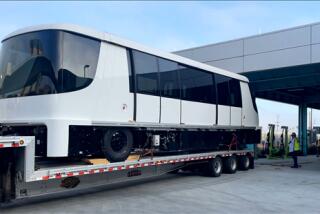Getting Trade on Right Track : ‘American Train’ Begins Yearlong Trip to Push Products in Japan
- Share via
In a Tokyo train station today, Japan will launch an unusual effort to help some U.S. companies railroad their way into Japanese markets and ease the nations’ massive trade gap.
An 11-car “American Train,” carrying U.S. items ranging from soup to skateboard helmets, will start a one-year trek across Japan to sell, or at least promote, American products. Organizers expect the goods to get lots of attention because they estimate that about 30% of Japanese shopping is done in and around train stations.
Painted red, white and blue, the train is scheduled to visit 50 cities and towns, spending about a week in each location. Not coincidentally, several stops will be in the sister cities of American cities, including Yokohama (San Diego), Mito (Anaheim), Sendai (Riverside) and Ota (Burbank).
Managing the trip are several prominent Japanese businessmen and politicians, led by former Prime Minister Yasuhiro Nakasone, and the East Japan Railway. But most of the U.S. companies are being charged rent to display their wares on the train.
The cost runs as high as $2.8 million for a firm leasing a full train car for the entire year. So far, only oil giant Exxon Corp. has opted for a whole car, said Tom Suber, vice president of John Ward & Associates, a Washington consulting firm that’s helping sell space on the train to U.S. companies.
The state of Hawaii also had planned to rent a full car, but withdrew June 2. In a letter to train organizers, Gov. John Waihee said there wasn’t enough time for Hawaii “to recruit private vendors and for them to put together the most effective display and sale of their products.”
For the companies willing to pay the fare, the train will provide valuable exposure, especially in outlying areas of Japan. But the big question is: Will the train put a major dent in the U.S. trade deficit with Japan, which totaled $52 billion last year? Even the train’s organizers concede that’s unlikely.
“It will provide the opportunity, but it’s no guarantee,” Suber said.
Critics of Japanese trade policy contend that a major cause of the trade gap is Japan’s complex product-distribution and tariff rules, which effectively block many American goods from ever reaching Japanese consumers. And the American Train is seen doing little to derail that system.
“This event does not directly address the concerns regarding access,” said James B. Vaughn, director of the California Office of Trade and Investment in Tokyo. “That’s one of the big problems that U.S.-based companies face, just figuring out and having access to the distribution system in Japan.”
However, the products aboard the American Train already have been cleared for sale in Japan, and Ryuichi Hattori, a spokesman in Los Angeles for the Japan External Trade Organization, said “the important thing” for those companies is that they “will learn about Japanese consumers’ tastes, and then they can promote further” based on what they learned.
Several big companies, such as Hewlett-Packard, Campbell Soup, American Express and Eastman Kodak, rented portions of the train cars, organizers said. Their cost is prorated by the amount of the car they rented: Half the car costs $1.25 million, one-quarter costs $625,000, and so on.
Levi Strauss, the apparel maker, also is jumping aboard by providing about 10 denim uniforms to each of the 300 people that will staff the train along its journey. At a cost of roughly $50,000, “that’s pretty darn good advertising,” said David Schmidt, president of Levi’s Japanese subsidiary in Tokyo.
Other firms, such as Besto Associates, a San Diego-based marketer of skateboard helmets, and the U.S. Mint, which plans to sell gold and silver coins, are renting kiosks that will be set up on the platforms alongside the train, Suber said. The kiosks have been rented by about 60 companies, which is “slightly lower than expected,” he conceded.
Companies can rent a kiosk for $150,000 for the full year, and they keep 90% of their sales. The other 10% goes to the train’s organizers. As an option, companies can rent a kiosk for free if they agree to keep only 30% of their sales until their sales reach $300,000. After that, they would split their sales with the organizers 50-50.
Another option exists for companies with seasonal products that they want to sell for only a few weeks or months. Those firms would pay $550 a day in rent and keep 90% of their sales.
Japan has called on promotions before to help battle the trade problem--with limited success.
In 1985, for instance, Nakasone tried to persuade each Japanese to buy $100 of U.S. and other foreign products. Nakasone, under U.S. pressure to slash what was then a $37-billion trade surplus with the United States, pleaded with Japanese “to be on the lookout for foreign products” when they went shopping. But the surplus only got bigger, and U.S. annoyance with Japan’s trade policy only increased.
Vaughn said the train won’t have much impact on the trade gap, either, because “the deficit is the result of tens of thousands of products moving in both directions, and one event in one sector of Japan is not going to have a significant impact.”
And Levi Strauss’ Schmidt noted that many of the train’s products, such as Kodak film and a pair of Levis, cost much less than the Japanese cars and televisions that flood the United States each year and contribute to Japan’s trade surplus. “You’ve got to move a lot of blue jeans to equate to one car,” he said.
More to Read
Sign up for Essential California
The most important California stories and recommendations in your inbox every morning.
You may occasionally receive promotional content from the Los Angeles Times.














